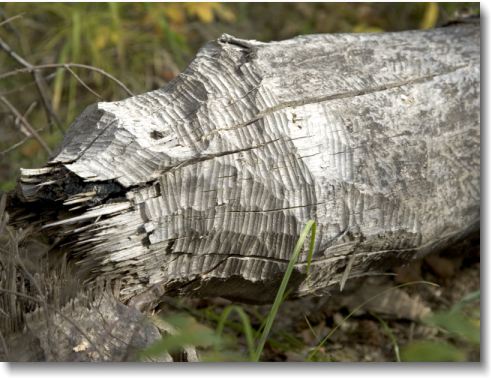
Dams
In areas where the natural water level is too low, beavers will construct a dam. [40] Once a beaver chooses a dam site, almost nothing can make him abandoned it. They have even been known to incorperate beaver traps in the construction of their dams! [41] A minimum water level of 2 to 3 ft. (.6 to .9 m) is required to keep the underwater entrance to their lodge from being blocked by ice during the winter. [42] [43] The average height of a dam is about 6 ft. (1.8 m) tall, with an average depth of water behind the dam of 4 to 6 ft. (1.2 to 1.8 m). The thickness of the dam is often around 5 ft. (1.5 m) or more. The length will depend on the stream width, but averages about 15 ft. (4.5 m) long. [44] [45] The longest beaver dam on record is 2,140 ft. (652. 2 m) long, 14 ft. (4.3 m) high, 23 ft. (7 m) thick at the base, found in Three Forks, Montana. [46] Beavers will vary the type of dam built and how they build it, by the speed of water on the river. In slow-moving water they may build a straight dam. Whereas in fast-moving water they tend to be curved. [47] Beavers start construction by diverting the stream to lessen the water's flow pressure. Branches and logs are then driven into the mud of the stream bed to form a base. Then sticks, bark (from deciduous trees), rocks, mud, grass, leaves, masses of plants, and anything else available, is used to build the superstructure. [48] [49] [50]
A beaver dam.
Image Source: NPS Photo by Harlan Kredit
Available in two sizes:
1024 x 768 || 800 x 600
A common myth is that beavers use their tail to carry and pack mud between branches. Instead, beavers carry mud by holding it against their chest. [51] Spillways and passageways are built into the dam to allow excess water to drain off without damaging it. [52] Dams are generally built wider at the base, and the top is usually tilted upstream to resist the force of the current. [53] Trees approaching the diameter of 3 ft. (.9 m) may be used, but the average size used to construct a dam is 4 to 12 in. (10 to 30 cm). [54] [55] The length will depend upon the diameter of the tree and the size of the beaver. A beaver can transport his own weight in material, and will drag the logs along mudslides and float them through canals to get them in place. [56] [57] There are recorded cases of beavers felling logs of as much as 150 ft. (45 m) tall and 5 ft. (115 cm) in diameter. [58] Logs of this size are not intended to be used as structural members, but rather the bark is used for food, and sometimes to get at upper branches. [59] [60]

A beaver-chewed log.
Image Source: Steve Hillebrand, U.S. Fish and Wildlife Service
Available in two sizes:
1024 x 768 || 800 x 600
It takes a beaver about 20 minutes to cut down a 6 in. (15.2 cm) wide aspen, by gnawing a groove around the trunk in an hourglass shape. [61] [62] Beavers are as sensible to the danger of a falling tree as a human lumberjack. As the tree begins to fall, the beaver will run! [63] A beaver's jaws are so powerful they can cut a half-inch sapling in one bite! [64] The beaver's pond is necessary for their food and housing. If the dam breaks, they will rush around frantically to repair it. If the they do not hurry, they could lose all of the water in their pond. This would expose the underwater lodge entrances to predators. [65] Every member of the colony will work constantly to keep the dam maintained and functioning. [66] Maintenance work on the dam and lodges is particularly heavy in autumn. [67] Once the dam has flooded enough forest area to the proper depth to form a protective moat for the lodge (often covering many acres), the beaver will begin construction on the lodge. [68] [69] [70]
Copyright © 2007 Beaver Pictures & Facts
Member of Fohn.net
Image Source for beaver lodge at top of page: M. LeFever, U.S. Fish and Wildlife Service.
Image Source for two beaver at bottom of page: Tom Smylie, U.S. Fish and Wildlife Service.

